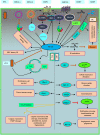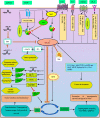The interplay between EBV and KSHV viral products and NF-κB pathway in oncogenesis
- PMID: 33072180
- PMCID: PMC7559203
- DOI: 10.1186/s13027-020-00317-4
The interplay between EBV and KSHV viral products and NF-κB pathway in oncogenesis
Abstract
Among the DNA tumor viruses Epstein-Barr virus (EBV) and Kaposi sarcoma herpesvirus (KSHV), account for a considerable percentage of virus-associated cancers. Deregulation of transcription factors signaling pathways is one of the most significant oncogenic characteristics of EBV and KSHV. NF-κB is a transcription factor that play a remarkable role in oncogenesis because of its function as a master regulator of a spectrum of genes involved in physiological and pathophysiological process. Constitutive activation of NF-κB is a frequent and well-described event in many human malignancies. Compelling evidence represent EBV and KSHV are capable of targeting different components of NF-κB cascade. Here, we summarized recent findings to clarify the precise relationship between dysregulation of NF-κB and EBV and KSHV-related malignancies. This essay also emphasizes on contribution of various viral products in developing cancer through alteration of NF-κB signaling pathway.
Keywords: EBV; KSHV; NF-κB; Neoplasm.
© The Author(s) 2020.
Conflict of interest statement
Competing interestsThe authors declare no conflicts of interests.
Figures



Similar articles
-
NF-kappaB is essential for the progression of KSHV- and EBV-infected lymphomas in vivo.Blood. 2006 Apr 15;107(8):3295-302. doi: 10.1182/blood-2005-07-2730. Epub 2005 Dec 27. Blood. 2006. PMID: 16380446 Free PMC article.
-
NF-kappaB signaling modulation by EBV and KSHV.Trends Microbiol. 2010 Jun;18(6):248-57. doi: 10.1016/j.tim.2010.04.001. Epub 2010 May 6. Trends Microbiol. 2010. PMID: 20452220 Review.
-
Upregulation of MicroRNA 711 Mediates HIV-1 Vpr Promotion of Kaposi's Sarcoma-Associated Herpesvirus Latency and Induction of Pro-proliferation and Pro-survival Cytokines by Targeting the Notch/NF-κB-Signaling Axis.J Virol. 2018 Aug 29;92(18):e00580-18. doi: 10.1128/JVI.00580-18. Print 2018 Sep 15. J Virol. 2018. PMID: 29976660 Free PMC article.
-
Kaposi's sarcoma herpesvirus (KSHV) microRNA K12-1 functions as an oncogene by activating NF-κB/IL-6/STAT3 signaling.Oncotarget. 2016 May 31;7(22):33363-73. doi: 10.18632/oncotarget.9221. Oncotarget. 2016. PMID: 27166260 Free PMC article.
-
[Epstein-Barr virus (EBV) and Kaposi's sarcoma-associated herpesvirus (KSHV, HHV-8)].Uirusu. 2010 Dec;60(2):237-45. doi: 10.2222/jsv.60.237. Uirusu. 2010. PMID: 21488336 Review. Japanese.
Cited by
-
Serum NF-κB in Epstein-Barr Virus-Related Oropharyngeal Carcinoma Diagnostic Usability.Cancers (Basel). 2024 Jun 25;16(13):2328. doi: 10.3390/cancers16132328. Cancers (Basel). 2024. PMID: 39001390 Free PMC article.
-
The ingenol-based protein kinase C agonist GSK445A is a potent inducer of HIV and SIV RNA transcription.PLoS Pathog. 2022 Jan 18;18(1):e1010245. doi: 10.1371/journal.ppat.1010245. eCollection 2022 Jan. PLoS Pathog. 2022. PMID: 35041707 Free PMC article.
-
Regulation of the Macroautophagic Machinery, Cellular Differentiation, and Immune Responses by Human Oncogenic γ-Herpesviruses.Viruses. 2021 May 8;13(5):859. doi: 10.3390/v13050859. Viruses. 2021. PMID: 34066671 Free PMC article. Review.
-
Cancers associated with human gammaherpesviruses.FEBS J. 2022 Dec;289(24):7631-7669. doi: 10.1111/febs.16206. Epub 2021 Oct 2. FEBS J. 2022. PMID: 34536980 Free PMC article. Review.
-
Nanotechnology Frontiers in γ-Herpesviruses Treatments.Int J Mol Sci. 2021 Oct 22;22(21):11407. doi: 10.3390/ijms222111407. Int J Mol Sci. 2021. PMID: 34768838 Free PMC article. Review.
References
-
- Brücher BL, Lang F, Jamall IS. NF-κB signaling and crosstalk during carcinogenesis. 4open. 2019;2:13. doi: 10.1051/fopen/2019010. - DOI
Publication types
LinkOut - more resources
Full Text Sources

